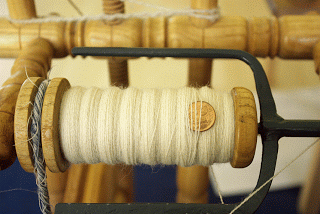My post about handspun yarn and pricing got the following comment by Stephanie Ann:
I run into this problem when pricing knitted items. I know I've worked X amount of hours on a project but know shop Y is selling theirs at prices so low.
I hear in the crafting community you should set a fair price or eventually you will not make enough to stay in business. I think it is probably true.
and since I found myself writing far more as an answer than should go in the comments sections, I'm just writing here now.
Yes, people in the crafting community often have their prices way too low. There's others with prices way too high, too - but those are few and far in between.
A professional crafter is a person having a freelance business. And they should calculate their prices accordingly - if you are a skilled crafter with a professional level of quality and you work 40 hours a week, you should be able to live off your earnings and pay your bills as well as put a little aside for disaster and old age. Just like you'd expect for somebody working a full job as an employee, right?
If you are interested in how much you would need to charge for your crafts, you can do the calculations yourself. Add up the costs of your material, the costs of energy (if you need power tools, fuel, heating, electrical lighting), and the costs of your tools. That's your basic material cost for your item. Now... if you have a day job, calculate what you are getting per hour - just roughly, so it's enough to divide your monthly gross wages by the amount of hours you work each month.
Depending on your line of work and the employer's taxes and social securities involved, you do cost your employer a good bit more than that - take your gross income per hour and take it times 1.5 or times 2. That is what you cost per hour. That is what you would need to charge per hour, in addition to the basic material cost for the items you make.
Now go get yourself a little booklet to jot down the hours you work on a project... I can about guarantee you will be very, very surprised after those calculations. (A project journal to jot down time spent on something plus details and observations, and dates worked on, is a very nifty thing to have anyways - just for yourself. I can absolutely recommend it.)
And this pricing is not including anything to cover the extra risks you have as a freelancer. After all, your employer has to pay you whether things are going well for the company or not - you have security there. If you are freelancer, you cannot assume that you can work for a customer all day, every day, and charge for that. So basically, you will need to recalculate your hourly rate so that it covers the non-paid work as well - your research, your skill enhancements, the time you need for travelling, sourcing materials, free consultations (yes, crafters will need to do that), and so on. You can find a nice little calculator here, for example, if you would like to play around with the idea a little.
So now you know what a fair price for your time would be. Has it surprised you? Is it way, way more than you thought it would be? Face it. That wold be a fair price for an item worked in a professional way, if crafting were your day job.
Now... can you picture somebody happily forking out that money?
(Post will be continued after Easter - regular blogging resumes on April 26. Have a wonderful Easter weekend, everybody!)
read part II of this series




